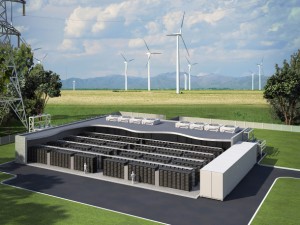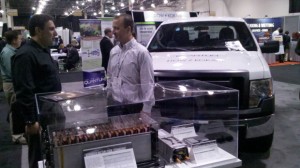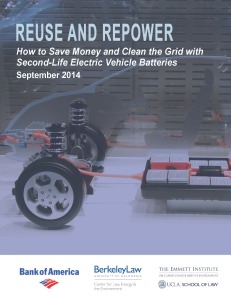At least one observer from last month’s Energy Storage North America doesn’t think so:
“Lithium ion was not fundamentally designed for grid scale storage,” said Andrew Chung, a partner at Khosla Ventures, during a panel at the conference. “Even with the Gigafactory, the cost won’t come down enough.”
Chung’s skepticism essentially revolved around the three complaints most often associated with lithium batteries: they cost too much, they can become a safety hazard and they have a limited lifespan. Utilities and commercial building owners want something that will last twenty years flawlessly.
 Others at the conference of course disagreed, noting that no new technology has managed to step in and fill the void like lithium ion, which covers a range of technologies. Still, it’s encouraging to see some large-scale flow batteries coming on-line to handle bulk storage duties, albeit still at the pilot-type scale.
Others at the conference of course disagreed, noting that no new technology has managed to step in and fill the void like lithium ion, which covers a range of technologies. Still, it’s encouraging to see some large-scale flow batteries coming on-line to handle bulk storage duties, albeit still at the pilot-type scale.
Maybe lithium ion can’t work in the long haul, but the article points to some good news for batteries competing with other grid resources. Basically, if your battery can deliver service for four hours, it can be competitive in the utility and grid operator markets. As prices come down generally and investment continues to flow, I think the future will only be bright for grid-scale storage, whatever the technology of choice may be.
The UCLA/Berkeley Law webinar on repurposing electric vehicle batteries for grid storage is now on-line. The September 19th event discusses key recommendations from the new report “Reuse and Repower” and features Adam Langton, Senior Energy Analyst at the California Public Utilities Commission, and Randall Winston, Special Assistant to the Executive Secretary in the Office of Governor Brown.
You can watch the one-hour video here or below:
For those in the San Francisco Bay Area, I’ll be on KCBS news radio (740AM) at 8:20am discussing the new UCLA/Berkeley Law report on repurposing used electric vehicle batteries for inexpensive grid storage. The report has gotten some nice coverage from Forbes, Scientific American, Charged Magazine, and the Daily Californian at UC Berkeley. Hope you can tune in!
UPDATE: You can listen to the broadcast here.
UC Berkeley Law will be hosting a webinar this morning from 10 to 11am Pacific Time on repurposing used electric vehicle batteries. It will feature:
- Adam Langton, Senior Energy Analyst, California Public Utilities Commission
- Randall Winston, Special Assistant to the Executive Secretary, Office of Governor Edmund G Brown, Jr.
The webinar will discuss the challenges and solutions to boosting a secondary market for the batteries. The market is still new and uncertain, and used EV batteries are only just now being deployed in various grid scenarios. The webinar comes on the heels of a new UCLA and UC Berkeley Schools of Law report, entitled Reuse and Repower: How to Save Money and Clean the Grid With Second-Life Electric Vehicle Batteries. I will be speaking on the key findings.
More information on the event can be found here, including the registration page. We will include time for questions from the audience.
Over the past two days, I attended the Battery Show conference outside of Detroit, Michigan, to hear what the leading entrepreneurs, researchers and automakers have to say about the state of electric vehicle batteries. While I was there to speak on a panel about a new report on repurposing electric vehicle batteries, I picked up some interesting themes about the most important clean technology out there, the battery. Here they are:
Carbon regulations & clean energy policies have been critical for pushing the battery market. Speaker after speaker spoke about the growing global policies on carbon, from California to the US EPA rule on power plants to Japan and China’s new emphasis on reducing pollution. Industry leaders estimate that the carbon regulations will result in a 4% per year rate of change in carbon emissions going forward. But the policies also include non-climate focused efforts, such as the new U.S. fuel economy standards. From 1975 to 2011, CAFE standards required only a 1.3% improvement per year on average, but from 2012 to 2025 they will require a 4.5% per year improvement, greatly benefiting clean vehicle technologies like EVs. And of course California’s leading policies on zero-emission vehicles and energy storage in general is providing a critical market foundation. One speaker said “we wouldn’t be here today talking about these issues without California’s leadership.”
 Lithium ion is still the most promising battery technology, with continued price reductions but no overnight breakthroughs. Speaker after speaker praised lithium ion as still the best battery technology out there, given its high energy density and low weight. Nobody foresees any other technology out there to rival it. In terms of cost and advances, it’s clear that costs will continue to decline, although not precipitously. By the end of this decade, most speakers believed Tesla will either achieve or come close to achieving the magic price/range of 200 miles per charge in a $35,000 EV. Improving manufacturing supply chains and automation will help tremendously, as the Tesla Gigafactory will be able to do.
Lithium ion is still the most promising battery technology, with continued price reductions but no overnight breakthroughs. Speaker after speaker praised lithium ion as still the best battery technology out there, given its high energy density and low weight. Nobody foresees any other technology out there to rival it. In terms of cost and advances, it’s clear that costs will continue to decline, although not precipitously. By the end of this decade, most speakers believed Tesla will either achieve or come close to achieving the magic price/range of 200 miles per charge in a $35,000 EV. Improving manufacturing supply chains and automation will help tremendously, as the Tesla Gigafactory will be able to do.
EV drivers want performance, not necessarily environmental benefits. Marketing and survey data clearly show that buyers concerned about fuel economy and environmental performance do not make up a huge percentage of the market. Instead, they want performance, style, and access to technology. Tesla has hit this magic formula well, as they downplay the environmental benefits of going electric. Perhaps Nissan should follow suit and rename the LEAF something less “green” sounding. After all, when I tell people what I like about my electric car, I always start with the superior performance of the electric drive, and then I finish by touting the fuel savings (which are huge) and the environmental benefits. I don’t do this strategically: it’s just the truth about what I’m most excited about with the car.
Repurposing batteries is a big open question, with lots of opportunities but lots of unknowns. Since it was the subject of my report, I was keen to hear people’s take on this topic. Many speakers who addressed the issue felt the potential is huge, noting the amount of energy storage available in electric vehicle batteries on the road today and in the near future. But many felt that these batteries would have to compete with the cost of recycling the batteries, which could become much cheaper through automation. And there are unknowns about how easy and cheap it will be to collect, verify, and stack the batteries for high-performance energy storage. But given the size of the opportunity and the environmental need, I encourage policy makers and industry to start analyzing the opportunities as thoroughly as possible, as outlined in the report.
Overall, it was a well-run conference that attracted an impressive group of speakers and leaders in the field. Cheap batteries will not only revolutionize transportation through electric vehicles, they will clean our grid when coupled with renewable resources. The solar+storage combo may also change the utility world forever: after all, who needs a utility if you and your neighbors can generate and store your own clean power? The disruption continues, while Michigan feels like a dream to me now.
 As I blogged about last week, California and the nation may have a golden opportunity to harvest used electric vehicle batteries for inexpensive energy storage. These repurposed batteries can be stacked for bulk storage to absorb surplus renewable energy for cloudy and dark windless times. They can save ratepayers money, clean the grid, and potentially help bring down the cost of electric vehicles, encouraging more people to switch from gas engines to cleaner electrics.
As I blogged about last week, California and the nation may have a golden opportunity to harvest used electric vehicle batteries for inexpensive energy storage. These repurposed batteries can be stacked for bulk storage to absorb surplus renewable energy for cloudy and dark windless times. They can save ratepayers money, clean the grid, and potentially help bring down the cost of electric vehicles, encouraging more people to switch from gas engines to cleaner electrics.
The numbers are compelling: California now has over 100,000 electric vehicles on the road today, with a goal of 1.5 million by 2025. Assuming 50 percent of the battery packs can be repurposed, with 75 percent of their original capacity, the “second-life” batteries on the road in just ten years could store and dispatch enough electricity to power 4.5 million households in any given moment, equivalent to almost 10 percent of the state’s installed power capacity.
But the market for these batteries is still new and uncertain. Used electric vehicle batteries are only just now being deployed in various grid scenarios, and automakers are concerned about uncertain liability in the event of damages, as well as the complex regulatory environment facing energy storage technologies in general.
To address the challenges and offer solutions, UCLA and UC Berkeley Schools of Law are today releasing the report Reuse and Repower: How to Save Money and Clean the Grid With Second-Life Electric Vehicle Batteries. I served as the lead author, and the report resulted from a one-day gathering of industry experts, including automakers, renewable energy developers, battery leaders, and utilities. It is the thirteenth in the law schools’ Climate Change and Business Research Initiative, sponsored by Bank of America, which develops policies that help businesses prosper in an era of climate change.
The report recommends that policy makers:
- support and partner with automakers, utilities, and other private sector entities to develop more second-life battery demonstration projects to document the market potential;
- Partner with industry leaders to identify and address the regulatory conflicts that limit the second-life battery market (often unintentionally); and
- Work with stakeholders to clarify product liability rules based on second-life battery performance standards.
To hear more about the report and the topic, UC Berkeley Law will be hosting a webinar this Friday from 10 to 11am with:
- Adam Langton, Senior Energy Analyst, California Public Utilities Commission
- Randall Winston, Special Assistant to the Executive Secretary, Office of Governor Edmund G Brown, Jr.
I will also be speaking on the report’s key findings. More information on the event can be found here, including the registration page. The webinar will include time for questions from the audience.
As a follow-up to my post on Elon Musk and Lyndon Rive’s talk at the Public Utilities Commission on Thursday, a few more comments stood out to me that may be worth relating:
- Tesla came within a few days of going bankrupt in Christmas 2008. The company secured a round of funds at the last minute. This drama was captured in the movie “Revenge of the Electric Car,” which is worth watching if you haven’t seen it. (It also captures Musk’s dysfunctional private life, which seemed like too much info for my tastes).
- Musk was convinced that Tesla and SpaceX (his rocket company) would fail. He did think SolarCity would succeed, but only because he had confidence in his cousin Lyndon. So much for the myth of the starry-eyed entrepreneur who bends reality to fit the vision.
- Musk launched Tesla not because he loved cars necessarily but because he identified the lack of sustainable energy as the critical challenge facing humankind. Energy storage and alternative-fueled cars are critical to addressing the problem. How many successful entrepreneurs start their companies not out of love of the product but because they believe it will address a critical environmental and societal need? My guess is Musk is unique — or at least unique in the sense that he’s been successful so far.
- Musk feels that burning oil for energy is a waste of a good product. He thinks oil has a higher value in the long term for plastics. He likened oil consumption for transportation to burning the furniture in your house for firewood.
- Along these lines, Musk wryly noted that one of the raw materials for batteries includes a byproduct of coal. But just a bit, he said.
- Musk foresees used Tesla batteries, once they’re no longer useful for driving but still have 60% capacity, being deployed for stationary energy storage. Either that or they’ll be completely recycled. Either way, he sees no waste resulting from the batteries.
- Tesla is experimenting with battery swapping, which takes 90 seconds to do (quicker than refilling a tank with gas). They will begin soon on the LA to San Francisco route to see if it’s popular. Personally, I don’t see how the ownership model works for this process. If you give up your Tesla car battery somewhere along Interstate 5, and you’ve paid tens of thousands of dollars for that battery as part of the car purchase, how do you know your new battery is just as good? It only seems like it could work if you lease your battery, but that business model did not work for Better Place.
Musk is under a lot of scrutiny these days given the high-flying success of Tesla (the stock is up over 600% in the last twelve months), so his comments can make an impact on the electric vehicle market just through the media attention they receive. But it’s worth giving his words and experience thought, given how he’s revolutionized the electric vehicle market — and soon the energy storage one — so far.


